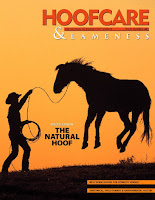The only “sure thing” number in the horse world is that most of the horses treated for lameness have four feet. Statistics quoted in the horse world range from the antiquated to the inflated, and professionals around the world are calling for more accountability of claims quoted in sales pitches and more quantification of the numbers that are quoted.
Once upon a time, someone somewhere said that 90 percent of equine lameness is in the foot, but does anyone know the original source of that quote? Would you say that is still true today? We can diagnose lameness a lot more precisely now than ever before.
One thing we do know: Hallmarq reports that, worldwide, almost 80% of lame horses referred for MRI at equine hospitals equipped with their MRI units have a problem located in the foot.
Where do you look for numbers when you need to prove a point? There is no “Fact Book” of equine lameness that collects statistics in one place. Instead, we all tend to trust certain authors or universities or studies. And everyone seems to have healthy skepticism for “the Internet”.
 |
| A high percentage of lame horses in both Great Britain and the United States have been found to have damage to the deep digital flexor tendon within the foot when standing MRI scans were analyzed. |
Mitchell found the most common defect in the lame American sport horses to be navicular bone lesions, which were seen in the Hallmarq MRI scans of 77 percent of the horses examined. But 64 percent of Mitchell’s horses had deep digital flexor tendon damage in the foot, as seen on their MRIs. Coffin joint collateral ligament damage was much less common in Mitchell’s group than in Dyson’s.
But the glaring damage to the tendon is a critical warning sign to sport horse owners and trainers on both sides of the Atlantic.
Ten years earlier, diagnosing damage to the tendon in the foot was almost impossible. Now, Dyson and Mitchell can even break down the tendon damage into types of injuries.
Dr Laurie Goodrich of Colorado State University College of Veterinary Medicine sums up the need for MRI when diagnosing horses with foot pain: “Of horses with caudal heel pain, 60 to 70 percent have soft tissue injuries that we won’t see with radiographs because they only determine bone structure.”
New imaging modalities like MRI are making earlier and more precise diagnoses possible; another number we like: information gleaned from images obtained via standing MRI resulted in a diagnosis in almost 90 percent of the cases referred, according to Hallmarq's data analysis of cases.
So, when you quote numbers in the equine lameness world, also mention your source, the year and the type of horses that were tallied. If the study covered a specific type of horses and if the study was conducted since the advent of diagnostic imaging like MRI, it may make your numbers mean a lot more. And someone else may end up quoting you.
To learn more:
The largest and most accessible body of quotable statistics is the U.S. Department of Agriculture’s National Animal Health Monitoring System (NAHMS) “Equine ’98 Study”, which collected facts and figures on the health of horses on farms and ranches in 28 states. This was amended by updates in 2000 and 2005.USDA, 2000. Lameness and Laminitis in U.S. Horses. USDA:APHIS:VS, CEAH, National Animal Health Monitoring System. Fort Collins, CO. Link to free download: http://www.aphis.usda.gov/animal_health/nahms/equine/downloads/equine98/Equine98_dr_Lameness.pdf
Dyson, Murray. Lameness associated with foot pain: results of magnetic resonance imaging in 199 horses (January 2001- December 2003) and response to treatment. Equine Vet Journal, 2004
Mitchell, Edwards, et al. Standing MRI Lesions Identified in Jumping and Dressage Horses with Lameness Isolated to the Foot, AAEP Proceedings, 2006.
--------
Watch for more in the Hallmarq-sponsored article series on The Hoof Blog, and check their social media system and especially their info-deep web site for lots more information.
To learn more about Hallmarq Veterinary Imaging and standing MRI technology for horses:
• Become a fan of the new Hallmarq Equine MRI Facebook page;
• Follow @HallmarqMRI on Twitter;
• Subscribe to the hallmarqvetimaging channel on YouTube.com;
• Watch for a growing equine distal limb Hallmarq MRI image gallery on Flickr.com;
• Visit the Hallmarq.net web site. (Plan to spend some time there!)














